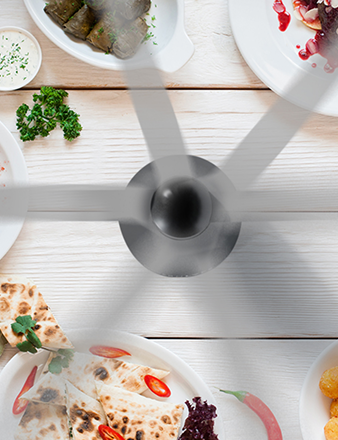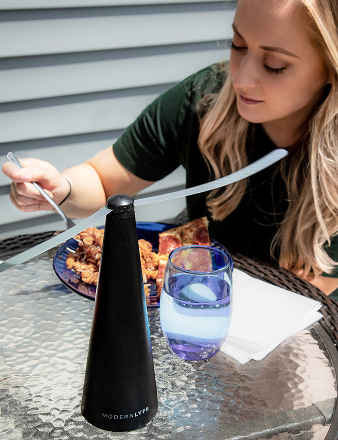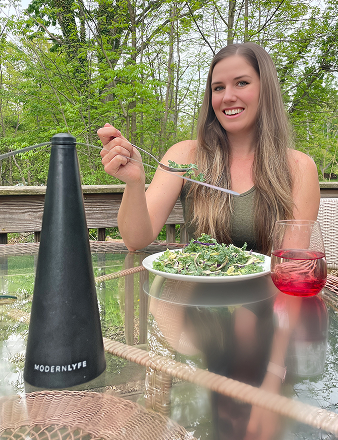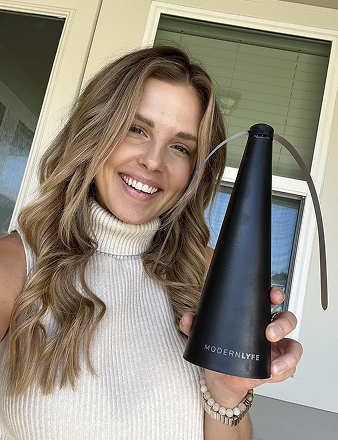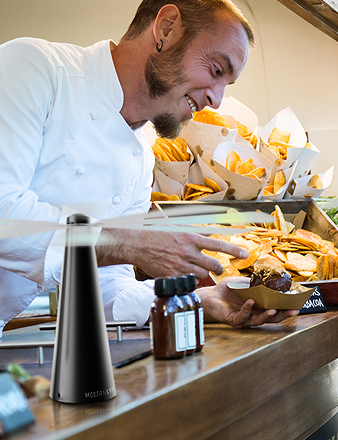A memorable outdoor space is no longer a luxury—it's a necessity. The right ambiance increases guest satisfaction, drives revenue, and builds a powerful brand identity. Creating a functional and stylish patio, rooftop, or garden, however, comes with unique challenges. This guide offers 10 distinct and actionable outdoor restaurant seating ideas, moving beyond generic advice to provide practical strategies for designing an outdoor area that looks incredible and operates flawlessly.
This roundup is for restaurant owners and managers looking to elevate their guest experience. You'll find fresh perspectives on everything from layout and flow to specific furniture choices. Understanding the importance of durable and stylish options is crucial. For detailed guidance, learn about choosing the right outdoor furniture for restaurants to find materials that match your brand and withstand the elements.
From classic patio dining to innovative terraced arrangements, each section provides insights you can use immediately. We'll cover practical needs like shading, lighting, and heating, ensuring your outdoor seating is as safe and comfortable as it is appealing. This is your resource for creating an outdoor destination that keeps customers coming back.
1. Patio Dining with Umbrellas and Shade Structures
The classic patio setup is a timeless and effective solution for outdoor restaurant seating. It combines tables and chairs on a paved or decked surface, protected by umbrellas or larger shade structures. Its versatility makes it a go-to for countless establishments, from bustling urban cafes to serene resort terraces.
This approach is highly adaptable, allowing for easy reconfiguration to accommodate different party sizes. It provides a structured yet open-air environment that guests appreciate. Elevating this common setup comes down to the quality of its components and thoughtful space planning.
Implementation and Best Practices
To create a patio that is both durable and inviting, focus on commercial-grade materials and a strategic layout. High-quality, weather-resistant furniture and robust shade systems are non-negotiable investments.
-
Foundation First: A solid, level foundation is critical. Whether you choose pavers, concrete, or wood, ensure the surface is even and allows for water runoff. Explore innovative patio decking ideas to build a sturdy and stylish base for your space.
-
Shade Strategy: Invest in commercial-grade umbrellas with heavy bases (50+ lbs) to withstand wind. For more coverage, consider a retractable awning or a permanent pergola that can be fitted with heaters and lighting. For a different approach, options like a 10x10 screened canopy can create a semi-enclosed space.
-
Weather-Proofing: Plan for all conditions. Use weighted tablecloths or clips to prevent them from flying away. Ensure your furniture is UV-resistant to prevent fading and quick-drying to handle unexpected rain.
2. Rooftop Bar and Lounge Seating
Rooftop bars and lounges use vertical space to offer an elevated dining experience. This premium outdoor restaurant seating idea transforms an underutilized building top into a destination with panoramic views and a sophisticated ambiance. The allure of dining above the city makes rooftops a powerful draw for special occasions and memorable nights.
This approach trades ground-level accessibility for unmatched scenery and a sense of escape. It sets an upscale or trendy tone, ideal for cocktail lounges and fine dining in dense urban environments. A successful rooftop space balances the "wow" factor of the view with practical considerations for safety, comfort, and structural integrity.
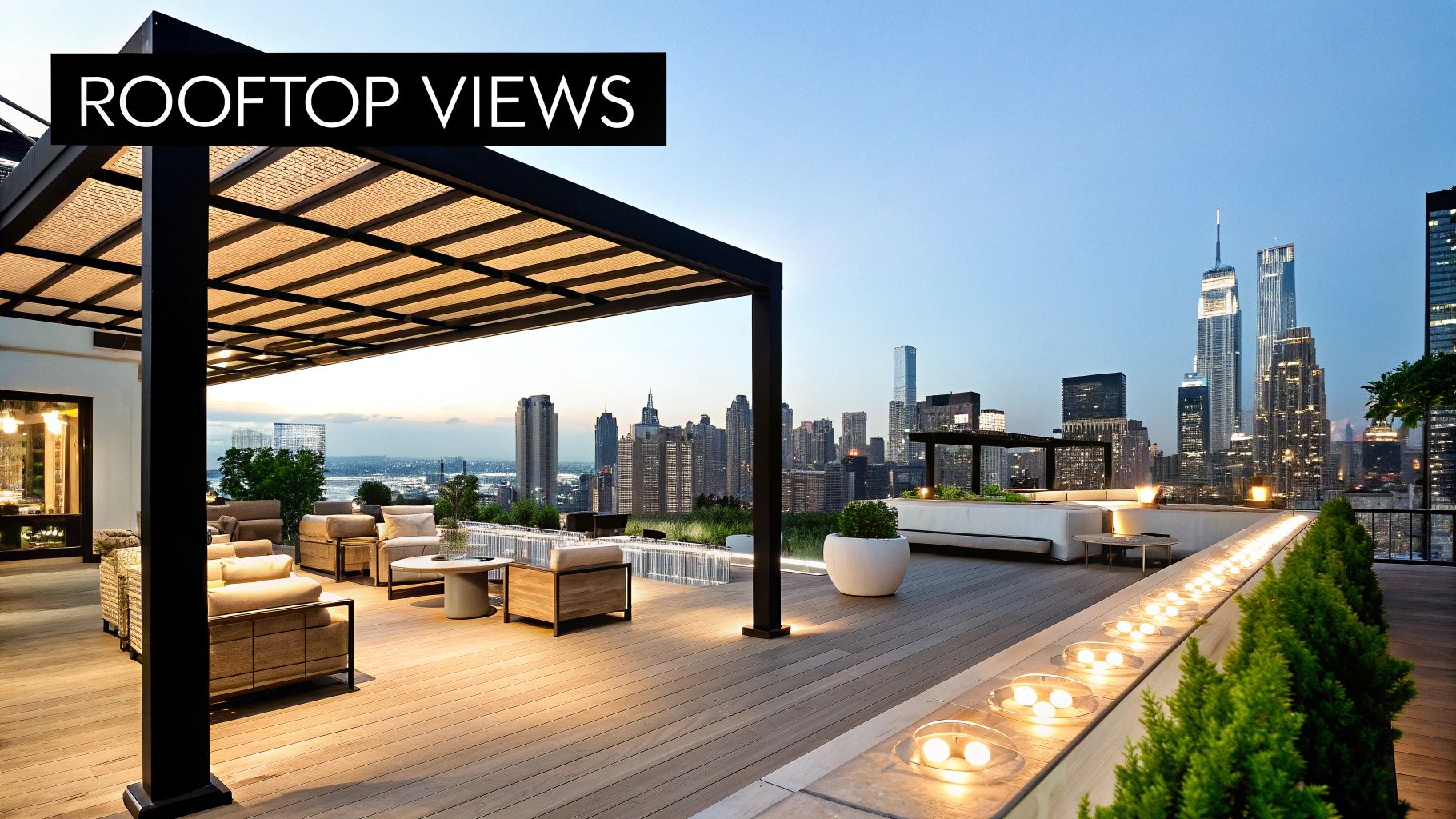
Implementation and Best Practices
A successful rooftop venue requires meticulous planning that addresses structural limits, weather exposure, and operational logistics. Safety and guest comfort are the top priorities.
-
Prioritize Safety and Structure: Safety is non-negotiable. Install high, sturdy railings or tempered glass barriers that exceed local building codes. Use lightweight yet durable furniture made from aluminum or synthetic wicker to minimize structural load. Always consult a structural engineer before starting a rooftop project.
-
Manage the Elements: Rooftops are exposed to stronger winds and direct sun. Secure all furniture and décor. Incorporate permanent windbreaks like partitioned glass and provide ample shade with pergolas or heavy-duty umbrellas. Heaters and fire pits are essential for extending the season.
-
Create Intimate Zones: A large, open rooftop can feel impersonal. Use planters, varied flooring levels, and distinct furniture groupings to create smaller, more intimate "zones." This breaks up the space and offers different seating experiences, from high-top tables overlooking the view to cozy lounge areas. An open-air environment can attract pests, so learn how to keep your restaurant fly-free to ensure guest comfort.
3. Garden and Botanical Setting Seating
Integrating seating within a lush garden creates a serene and immersive experience. This approach involves designing seating as part of a living landscape, making it one of the most transportive outdoor restaurant seating ideas. It's perfect for establishments aiming for a tranquil, nature-forward ambiance.
This concept taps into the biophilic design trend, connecting guests with nature to enhance their well-being. The goal is to create a seamless blend where the garden is not just a backdrop but an integral part of the experience.

Implementation and Best Practices
A successful garden dining area requires a balance of horticulture and functional design. The goal is a space that is both beautiful and manageable.
-
Strategic Landscaping: Collaborate with a landscape designer to select plants suited to your climate and maintenance capacity. A mix of perennials, annuals, and evergreens ensures visual interest year-round. Using native and drought-resistant species can reduce water usage and upkeep.
-
Thoughtful Layout: Arrange seating to offer varied perspectives of the garden. Create intimate nooks surrounded by foliage as well as open areas with panoramic views. Use subtle pathways and low barriers like small hedges to guide foot traffic and protect plants.
-
Ambiance and Lighting: Use lighting to highlight features like specimen trees or water elements after dusk. Low-voltage uplighting, string lights, and pathway markers create a magical atmosphere. Plan your lighting and planting for year-round appeal as the garden changes seasonally.
4. Outdoor Lounge and Daybed Seating
Moving away from traditional tables and chairs, outdoor lounges and daybeds transform dining into a luxurious, leisurely social event. This concept uses low-profile sofas, plush daybeds, and conversational banquettes to create an atmosphere of relaxed sophistication. It's a popular choice for venues aiming to encourage guests to linger, such as rooftop bars and beach clubs.
This approach focuses on enhancing the guest experience rather than maximizing turnover, promoting a communal and comfortable vibe. It is one of the most effective outdoor restaurant seating ideas for venues serving small plates and cocktails, where social interaction is key. Success lies in curating a space that feels exclusive, private, and effortlessly chic.
Implementation and Best Practices
To create a functional and inviting lounge, focus on high-quality materials, thoughtful arrangement, and impeccable service. The furniture itself becomes the centerpiece.
-
Furniture and Fabric Selection: Invest in commercial-grade, all-weather lounge furniture with quick-drying, UV-resistant cushions. Performance fabrics like Sunbrella are industry standards for durability and easy maintenance.
-
Create Intimate Zones: Arrange furniture in conversational groupings to foster privacy and intimacy. Use area rugs, planters, or decorative screens to visually separate zones. Ensure adequate spacing for comfortable movement and discreet service.
-
Functional Design: Every seating group needs functional surfaces. Provide sturdy, low-profile side tables or coffee tables for drinks and food. The table height should be comfortable to reach from the low-slung seating.
-
Elevate with Ambiance: Soft, ambient lighting is crucial for a relaxed evening mood. Use a mix of string lights, lanterns, and subtle uplighting on surrounding foliage. Attentive service is paramount in this less formal setting.
5. Waterfront and Dock Seating
For establishments on a lake, river, or coastline, waterfront seating is an unparalleled outdoor restaurant seating idea. This approach places tables directly on piers, floating platforms, or waterside decks, making the scenery the main attraction. It capitalizes on the serene and dynamic beauty of the water.
This concept offers a powerful sensory experience that sets a restaurant apart, from the sound of lapping waves to panoramic sunset views. It’s an ideal setup for seafood restaurants and upscale resorts looking to provide a distinct sense of place. This strategy turns a great location into an unforgettable destination.
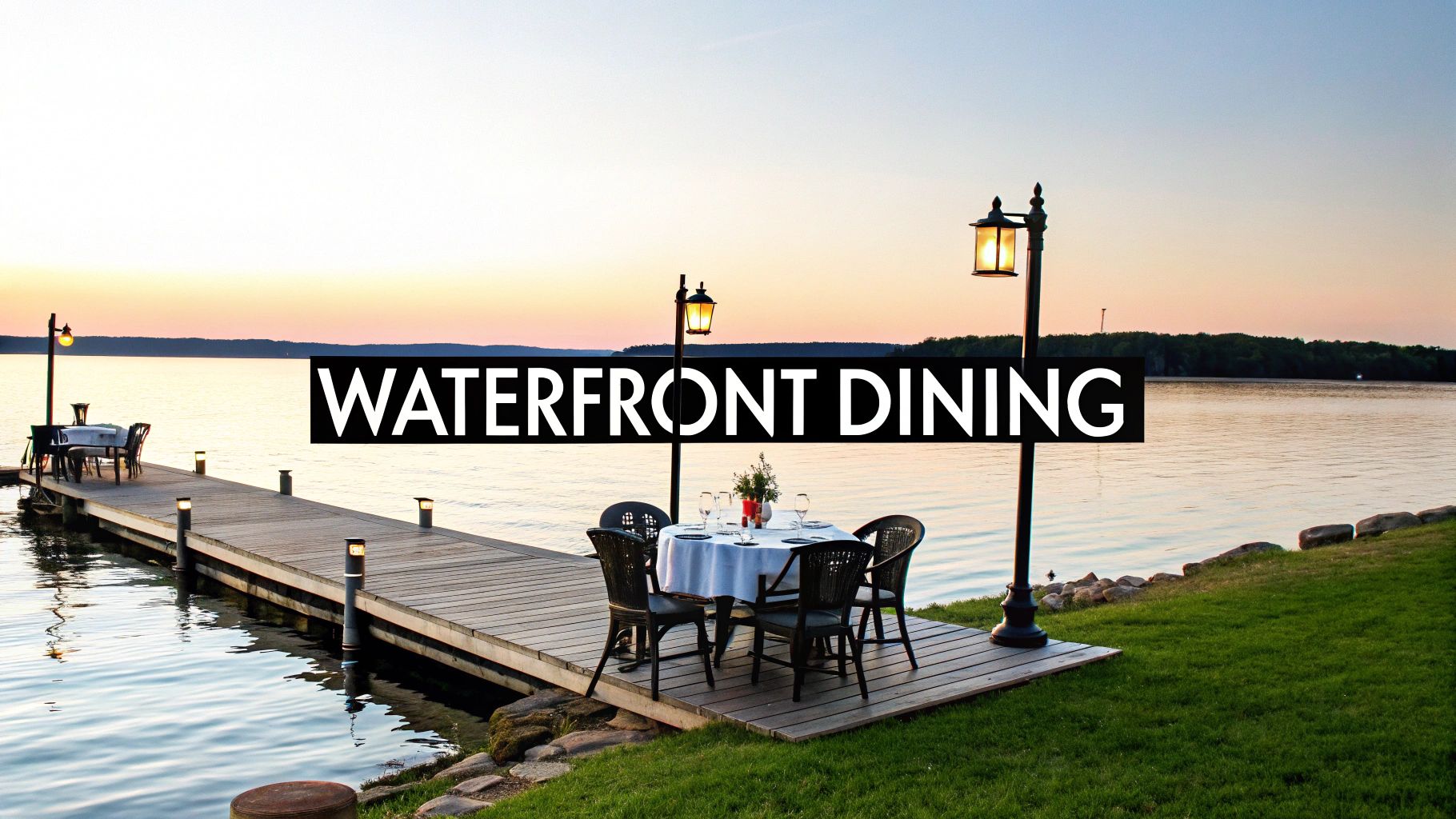
Implementation and Best Practices
Creating a safe and durable dockside dining area requires specialized materials and a focus on safety. The unique environmental challenges demand a higher standard of planning and maintenance.
-
Marine-Grade Materials: Constant exposure to moisture requires corrosion-resistant materials. Opt for stainless steel (grade 316), aluminum, or galvanized steel for furniture. For decking, choose composite materials or treated hardwoods like teak that naturally resist rot.
-
Safety is Paramount: Go beyond standard requirements. Install robust safety railings that are higher and stronger than code dictates. Surfaces must be non-slip, even when wet. Schedule regular structural inspections of the dock or pier.
-
Plan for Nature: Design your space to accommodate fluctuating water levels and potential storms. Install effective windbreaks, like tempered glass panels, that protect diners without obstructing the view. Ensure all furniture is heavily weighted or can be securely anchored.
6. Communal and Picnic Table Seating
Communal and picnic-style seating is one of the most effective outdoor restaurant seating ideas for creating a vibrant, social atmosphere. This approach uses long, shared tables to break down barriers between parties, fostering a sense of community. It's ideal for beer gardens, food halls, and casual eateries aiming for a friendly vibe.
This layout efficiently maximizes seating capacity while promoting a high-energy environment. Inspired by German beer gardens and the farm-to-table movement, this style feels both traditional and modern. It signals that the establishment is a place for connection, making it appealing for groups.
Implementation and Best Practices
Successful communal seating balances a social atmosphere with guest comfort and operational efficiency. The right materials and arrangement are crucial.
-
Durable and Functional Materials: Opt for heavy-duty, weather-resistant materials like pressure-treated wood, recycled plastic, or powder-coated metal. Surfaces should be non-porous and easy to clean for quick turnover.
-
Manage Space and Flow: While the goal is community, adequate spacing is still key. Ensure there is enough room between benches for easy entry and exit, and maintain clear, wide pathways for servers and guests.
-
Enhance the Guest Experience: Small details improve comfort. Equip tables with caddies for condiments, napkins, and utensils. You can also explore essential accessories for a picnic that can elevate the experience, like portable lighting or cushions.
-
Provide Flexible Options: While large communal tables are the main attraction, include a few smaller tables nearby. This provides an alternative for couples or smaller groups who may prefer a more intimate setting.
7. High-Top Bar and Counter Seating
High-top tables and counter-style seating introduce a dynamic, social atmosphere to an outdoor space. This approach, common in modern bistros and cocktail lounges, leverages vertical space to create distinct zones for mingling or quicker meals. It's an excellent solution for fostering a lively, high-energy environment.
This style is effective for maximizing views over railings or creating separation from traditional dining areas. Outdoor counter seating offers a unique perspective and promotes faster turnover, making it a strategic choice for high-traffic venues. The key is to balance its casual nature with comfort and stability.
Implementation and Best Practices
To successfully integrate high-top seating, focus on guest comfort, flow, and durability. The materials and layout must support an interactive setting while ensuring safety.
-
Ergonomics and Comfort: Prioritize high-quality, commercial-grade bar stools with ergonomic support, backrests, and sturdy footrests. Uncomfortable seating can shorten a guest's stay. Ensure stools have a stable base suitable for outdoor surfaces.
-
Strategic Placement and Flow: Use high-tops to define perimeters, line railings with scenic views, or create a social hub near the bar. Maintain adequate spacing (at least 36 inches between tables) to allow clear pathways.
-
Durable and Practical Materials: Select weather-resistant materials like powder-coated aluminum or high-density composite for tables and stools. For countertops, consider non-porous surfaces like quartz or sealed concrete that are easy to clean. Installing under-counter hooks for bags is a thoughtful touch.
8. Glamping and Outdoor Pavilion Seating
Glamping and pavilion-style seating elevate outdoor dining to a luxurious event, blending indoor comfort with natural beauty. This approach uses elegant, semi-permanent structures like high-end tents, yurts, or open-air pavilions to create sophisticated, weather-resistant dining spaces. It's perfect for destination venues aiming for an exclusive atmosphere.
This concept caters to the demand for experiential dining, where ambiance is as crucial as cuisine. It allows for private, intimate settings ideal for special events or VIP groups. The key is to fuse rugged outdoor charm with refined interior comforts, making it a standout among outdoor restaurant seating ideas.
Implementation and Best practices
Executing a glamping or pavilion concept requires a seamless, high-end experience from the structure to the service. Quality and ambiance are paramount.
-
Structure and Foundation: Invest in commercial-grade, all-weather tent structures or pavilions. Ensure they are professionally installed on a stable, level foundation like a wooden deck or compacted gravel base. The structure must be rated to withstand local weather conditions.
-
Climate Control and Comfort: Comfort is critical. Install professional-grade heating systems for cooler months. For warmer weather, ensure excellent ventilation with roll-up sides or quiet fans. Offering amenities like plush blankets adds a luxurious touch.
-
Ambiance and Furnishings: Use sophisticated, comfortable furnishings you would find indoors. Layered lighting is essential: combine overhead ambient light with table lamps and accent lighting like string lights to create a warm glow. High-quality linens and elegant decor complete the experience.
9. Street and Alfresco Seating
Street and alfresco seating transforms sidewalks, plazas, and even temporarily closed streets into dynamic dining areas. Inspired by European cafés, this approach extends your restaurant's footprint into the public sphere. It creates an immersive, community-centric atmosphere that is highly visible and inviting.
This setup is particularly effective in urban areas with high foot traffic, as it captures spontaneous diners. It's a powerful tool for activating the streetscape and contributing to a neighborhood's vitality. Executing this idea successfully requires navigating local regulations, but the payoff is a bustling, magnetic dining experience.
Implementation and Best Practices
Success with alfresco seating hinges on regulatory compliance, operational efficiency, and guest comfort in a public setting. Prioritize mobility, durability, and a clear brand identity.
-
Navigate Regulations First: Before buying anything, research and secure all necessary permits from your local municipality. Regulations often dictate the footprint, barrier requirements, and hours of operation.
-
Prioritize Mobility and Storage: Since this furniture often needs to be brought in nightly, choose lightweight yet durable options. Stackable chairs and foldable tables made from aluminum or resin are ideal. An organized nightly storage system is crucial.
-
Define Your Space: Use attractive yet sturdy barriers like branded planters or low-profile fencing to delineate your dining area. This creates a sense of enclosure for guests while ensuring clear, safe pathways for pedestrians, meeting ADA compliance.
-
Focus on Durable Materials: Your furniture will face significant wear from weather and constant movement. Opt for commercial-grade, weather-resistant materials that are easy to clean and withstand a bustling urban environment.
10. Tiered and Terraced Seating Arrangements
For restaurants with sloped terrain, tiered and terraced seating is a show-stopping outdoor restaurant seating idea. This approach organizes dining areas on different elevations using terraces or built-in platforms. It transforms a landscape challenge into a stunning feature, maximizing views and creating distinct dining zones.
This design adds visual drama and a sense of exclusivity to each level. Guests feel they have their own private viewpoint, separated from other tables. The arrangement is particularly effective for venues with a natural vista to showcase, such as a coastline or city skyline.
Implementation and Best Practices
A terraced design requires careful engineering, a focus on safety, and a plan for operational efficiency. The goal is a seamless experience for both guests and staff across multiple levels.
-
Safety and Accessibility First: Sturdy railings and clear safety barriers are non-negotiable on all elevated sections. Design steps with consistent, gentle inclines and adequate lighting. Incorporate accessible pathways or designate a prime, reachable section on a lower tier for ADA compliance.
-
Optimize Flow and Sightlines: Plan server routes to be as efficient as possible, perhaps with service stations on different levels. Each tier should be designed to preserve the sightlines of the levels above and below it.
-
Create Ambiance: Use landscaping like low-profile planters to soften the hardscape of retaining walls. Implement distinct lighting schemes for each level to create unique moods. Terracing can also create effective windbreaks.
-
Drainage is Crucial: A multi-level structure must have a robust drainage system to prevent water from pooling on lower terraces. Engineer each level with a slight grade to direct runoff away from seating areas.
Outdoor Restaurant Seating: 10-Option Comparison
| Seating Type | 🔄 Implementation complexity | ⚡ Resource requirements | ⭐ Expected outcomes | 📊 Ideal use cases | 💡 Key advantages / Tips |
|---|---|---|---|---|---|
| Patio Dining with Umbrellas and Shade Structures | Low — simple install; seasonal adaptability | Low–Medium — furniture, umbrellas, bases; optional permanent structures | ⭐⭐⭐⭐ — versatile comfort, reliable occupancy | Casual & fine dining, resorts, pop-up events | 💡 Affordable and reconfigurable; use commercial-grade umbrellas and weighted bases |
| Rooftop Bar and Lounge Seating | High — structural work, permits, safety systems | High — engineering, HVAC/heaters, wind protection, lighting | ⭐⭐⭐⭐ — premium pricing, strong appeal | Urban nightlife, hotels, event venues | 💡 Offers unique views; use lightweight furniture, safety railings and windbreaks |
| Garden and Botanical Setting Seating | Medium–High — landscaping, irrigation, seasonal planning | High — horticultural expertise, irrigation systems, ongoing maintenance | ⭐⭐⭐⭐ — memorable, high brand/IG appeal | Farm-to-table, resorts, experiential fine dining | 💡 Create serene ambiance; choose native plants and hire landscape professionals |
| Outdoor Lounge and Daybed Seating | Medium — layout, weatherproofing, service model changes | Medium — high-quality lounges, cushions, frequent cleaning | ⭐⭐⭐ — increases dwell time and spend | Beach clubs, pool venues, upscale casual restaurants | 💡 Encourages longer stays; use outdoor-grade cushions and frequent maintenance |
| Waterfront and Dock Seating | High — marine construction, permits, safety & access | High — marine-grade materials, structural inspections, corrosion control | ⭐⭐⭐⭐ — unique experience, justifies premium pricing | Coastal restaurants, tourist destinations, seafood concepts | 💡 Spectacular views and cooling effect; use corrosion-resistant materials and regular inspections |
| Communal and Picnic Table Seating | Low — simple construction and layout | Low — durable benches/tables; cleaning systems | ⭐⭐⭐ — high capacity, social atmosphere, cost-efficient | Beer gardens, festivals, casual communal dining | 💡 Maximizes capacity and interaction; use easy-clean materials and optional dividers |
| High-Top Bar and Counter Seating | Low–Medium — counters and stool selection | Low — bar stools, counters, footrests | ⭐⭐⭐ — faster turnover, social/interactive vibe | Cocktail bars, bistros, open-kitchen concepts | 💡 Good for compact spaces; choose ergonomic stools and provide footrests |
| Glamping and Outdoor Pavilion Seating | High — bespoke structures, climate control, utilities | Very High — premium tents, HVAC, lighting, linen, staffing | ⭐⭐⭐⭐ — high revenue per guest, highly memorable | Luxury resorts, destination events, private functions | 💡 Enables year-round outdoor dining; invest in quality structures and professional climate systems |
| Street and Alfresco Seating | Low — simple setup but requires permits | Low — portable furniture, storage, permit compliance | ⭐⭐⭐ — high visibility, drive walk-ins, low startup cost | Urban cafés, pop-ups, casual dining on sidewalks | 💡 Very low cost and flexible; confirm local regulations and use mobile durable furniture |
| Tiered and Terraced Seating Arrangements | High — earthworks, engineering, safety & drainage | High — structural work, railings, drainage systems, accessible paths | ⭐⭐⭐⭐ — maximizes views, creates intimate zones, visual impact | Hillside resorts, vineyards, scenic clifftop restaurants | 💡 Great for views and space efficiency; prioritize railings, drainage and accessible routing |
Bringing Your Vision to Life: Key Considerations
Transforming a blank patio into a profitable outdoor dining space requires more than stylish furniture. The most successful outdoor restaurant seating ideas create a complete, immersive experience. They craft an environment where guests want to linger, celebrate, and return.
A well-executed outdoor area becomes a destination. It acts as a powerful marketing tool that draws in passersby and generates buzz on social media. More importantly, it directly impacts your bottom line by expanding seating capacity and enhancing your brand's appeal. The key is to master the execution.
From Blueprint to Reality: Your Actionable Checklist
A great outdoor space blends creativity with practicality. As you move forward, focus on these critical pillars that support every successful outdoor dining concept.
-
Prioritize Guest Comfort: Ambiance is multisensory. Your design must account for the elements. Proactive solutions for shading, heating, and cooling are essential for a positive experience year-round. A guest who is too hot or cold is a guest who won't stay long.
-
Integrate Seamless Practicality: Smooth operations are the invisible engine of a great guest experience. This includes crucial elements like pest control. Instead of clunky or loud solutions, consider how elegant technology like sleek, quiet fly fans can protect the dining atmosphere without compromising aesthetics.
-
Champion Safety and Universal Access: A truly welcoming space is safe and accessible to everyone. Adhering to ADA guidelines, ensuring clear pathways, and using non-slip surfaces are non-negotiable. This commitment ensures compliance and sends a powerful message of inclusivity.
-
Plan for Longevity: Your outdoor seating is a significant investment. Protect it by choosing durable, weather-resistant materials and establishing a routine cleaning schedule. Factoring long-term operational costs into your initial budget prevents costly future repairs.
The Final Ingredient: A Cohesive Guest Journey
Ultimately, the most impactful outdoor restaurant seating ideas are those that tell a cohesive story. Every element—from furniture and lighting to music—should align with your restaurant's brand identity. A waterfront deck should feel open and refreshing, while a hidden garden should evoke intimate escape.
By combining an innovative seating concept with these pillars of comfort, safety, and operational excellence, you do more than just add tables. You create a memorable destination that enhances your brand, delights your guests, and drives sustainable growth.
Ready to perfect your outdoor ambiance? Ensure an uninterrupted, pest-free dining experience with premium, aesthetically designed fly fans from MODERN LYFE. Visit MODERN LYFE to discover how our silent, stylish solutions can protect your guests and elevate your outdoor space.

